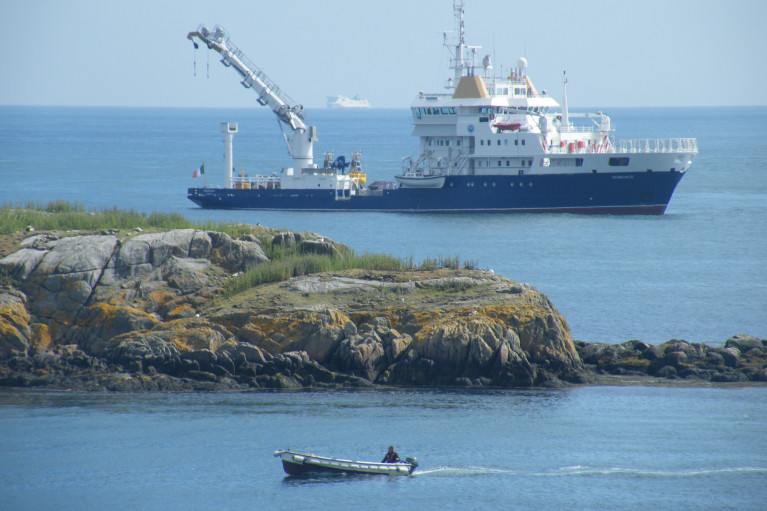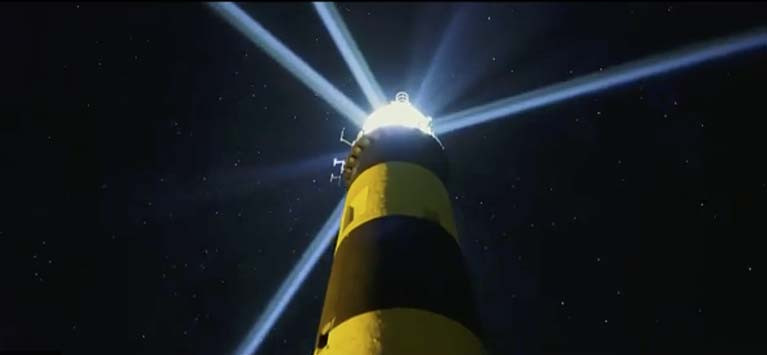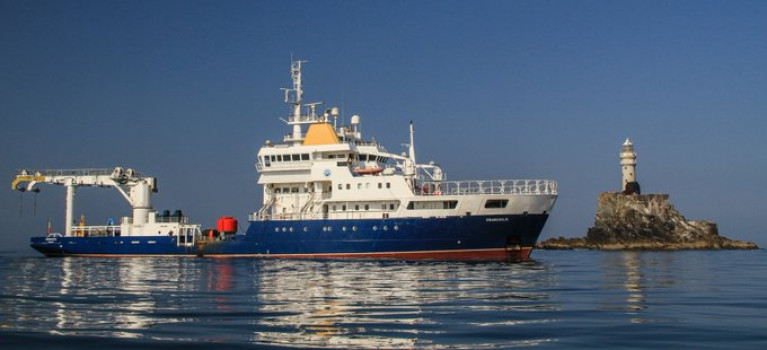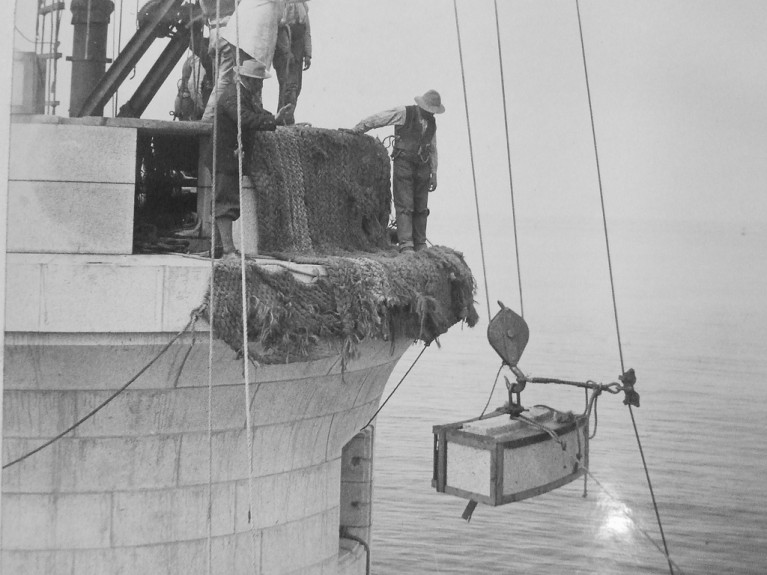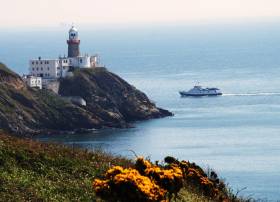Displaying items by tag: Irish Lights
All three General Lighthouse Authorities (GLA) of the UK and Ireland - Trinity House, the Northern Lighthouse Board and Irish Lights - will discontinue their Differential GPS (DGPS) service in March 2022.
The GLAs made this decision after carefully considering the results from an extensive consultation carried out with stakeholders and service users. They will cease transmission of the signal after 31 March 2022.
It was in 1995 that the GLAs introduced DGPS as part of the mix of marine aids to navigation (AtoN) provided to safeguard mariners within their combined waters and to help protect the environment. The system became fully operational in 1997. The system consists of 14 DGPS reference stations, six far-field monitoring sites and three monitoring and control sites. The system is operated as a single AtoN, operated and maintained by the three GLAs.
Dr Alan Grant, GLA DGPS System Director, said: “After careful consideration of the results of the consultation process, the three GLAs have concluded that their DGPS system is now redundant. Today’s GNSS are able to meet all but the most stringent accuracy requirements, and position integrity can be provided by alternative means (RAIM or other visual and electronic aids to navigation).
“The GLAs recognise the need to provide adequate notice and support continuity of service going forward. As such, the DGPS system will remain operational until 31 March 2022, at which point the signals will cease.”
Background
Marine radiobeacon DGPS was developed by the GLAs to counter Selective Availability (SA), a deliberate error added to the civilian GPS service to degrade its positional accuracy. The DGPS correction to the position error meant an improvement in accuracy from approximately 50m to around 5m.
In addition to improving the estimated position accuracy, by assessing whether the error is within a given threshold, the reference station is able to monitor the performance of the GPS constellation and identify any faults. Faulty satellites are removed from the position solution, providing position integrity for the mariner.
SA was discontinued in 2000 and GPS now offers the civilian user a position accurate to around 3-5m. DGPS still improves positional accuracy - now enabling positions in the region of 1-2m - but it is the position integrity function that is most often cited as the main benefit of DGPS.
While marine radiobeacon DGPS is not mandated by the International Maritime Organization for carriage on SOLAS vessels, it is provided for in all maritime receiver standards and the spectrum is allocated internationally.
Consultation
The infrastructure required to run the service is approaching the end of its design life; the GLAs conducted a stakeholder consultation to assess the requirements for the service going forward, surveying and interviewing stakeholders from across the maritime sector and beyond.
Of the responses received, 86% were from mariners and maritime operators, operating a wide range of vessels including ferries, container ships, tankers, liquid natural gas carriers, bulk carriers and leisure craft.
The survey resulted in a mix of responses, with the majority of mariners reporting that they use the DGPS system for accuracy improvements and integrity, while others reported that they do not use it.
All mariners reported using GPS today with around 40% also making use of GLONASS, and around 9% using Galileo too. From the response received, it is expected that more mariners will move to multi-constellation receivers, making use of GPS, GLONASS, Galileo and BeiDou over the next five to ten years.
Maritime Safety
Following a change in maritime receiver standards in 2003, all receivers now include Receiver Autonomous Integrity Monitoring (RAIM). RAIM is a means of determining whether the resulting position estimate is safe to use through an algorithm within the receiver.
Differential corrections are also available from other sources, including Satellite Based Augmentation Systems (SBAS), which are primarily provided for aviation users. Work is under way in Europe to introduce a maritime service to EGNOS, the European SBAS. This service is expected to be available around 2022.
Vessels that need high accuracy position and integrity for operations mainly utilise a number of commercial satellite-based services; the decision to discontinue DGPS has no operational impact on these services.
The GLAs advise mariners to consider their use of DGPS and to plan for its discontinuance accordingly. Mariners should check their GNSS receiver(s) to confirm the presence of RAIM and consider upgrading to type-approved SBAS receiving equipment when available.
The GLAs encourage mariners to use all available AtoN - whether visual or electronic - to support their safe passage and the protection of the environment.
To download a PDF copy of the full DGPS article by Dr Alan Grant click here
Numbering a handful of men that still tend Ireland's lighthouses, but a move, writes Independent.ie, to renewable energy is bringing their unique way of life to an close.
'I can think of no other edifice constructed by man as altruistic as a lighthouse," George Bernard Shaw once said. "They were built only to serve."
Even after the leap in navigational technology represented by GPS, they maintain that historical function: shining a light for miles around, warning sailors and ships of dangers lurking beneath the surface.
The way they are powered is changing, though, and with it the work of the people who tend them.
The tradition of constantly manned lighthouses ended on March 24, 1997, but the lightkeepers' cottages are still inhabited for weeks at a time by maintenance staff who service the lights' diesel-powered motors.
Today, Irish Lights workers travel to sites including Fastnet Rock off Co Cork, Tuskar Rock off Co Wexford, Inishtrahull Island off Co Donegal, Slyne Head off Clifden in Co Galway and Kish Tower in Dublin Bay.
By 2025, however, all lighthouses, beacons and buoys dotted around the coast and in Irish waters will be powered by renewables. The amount of work for technicians who stay at remote lighthouses will fall.
To read more here including from Yvonne Shields O'Connor, chief executive of Irish Lights which is withdrawing from lighthouses' accommodation quarters.
Transportation by sea is the most important means of connecting Ireland to international markets, according to one of Ireland’s leading maritime authorities.
Speaking on IALA World Aids to Navigation Day (AtoN) on Wednesday, July 1, the CEO of Irish Lights, the organisation responsible for delivering maritime safety services on an all-island basis, highlighted that maritime transport accounts for more than 90% of Ireland’s international trade, in volume terms.
(Afloat adds that IALA is an organisation of the International Association of Marine Aids to Navigation and Lighthouse Authorities).
“Food, fuel, medical supplies and other essential goods are transported by sea, and as an island nation, Ireland’s dependence on open, safe maritime channels cannot be overstated. This was particularly evident through the recent Covid-19 pandemic,” said Yvonne Shields O'Connor.
Irish Lights, the organisation responsible for safe navigation at sea, uses its network of lighthouses, beacons, buoys and virtual and electronic Aids to Navigation to ensure safe passage. Both onshore and at sea, Aids to navigation, also known as AtoN, are critical to navigation and enhance safety and provide security to marine users, from large vessels transporting essential goods, to fishing and leisure users and more.
“Our seafood industry contributes €1.22 billion to Irish GDP and is a vital part of our coastal economy. Aids to Navigation are critical to the safe operation of over 2,300 fishing vessels registered in Ireland and Northern Ireland and many more foreign vessels working in our waters.The leisure fleet returning to the water following the Covid-19 restrictions is heavily dependent on the Aids to Navigation provided by Irish Lights and by Local Lighthouse Authorities such as County Councils, Ports and Harbours,” said Ms Shields O’Connor.
Aids to Navigation today are a technologically advanced mix of visual aids such as lighthouses, buoys, and beacons; and electronic aids such as Radar Beacons (Racon), Automatic Identification Systems (AIS) and Differential GPS (DGPS). The use of solar, battery and LED technology is facilitating improved services to the mariner and the use of renewable energy for our AtoN systems.
Keeping maritime channels operating effectively will continue to be ever more important as economic activity increases and as tourism and leisure intensifies over the summer.
A great summer activity to consider is a visit to one of Irish Lights lighthouses, all of which are functioning Aids to Navigation.
There are 14 Lighthouses accessible to the public through the Great Lighthouses of Ireland partnership www.greatlighthouses.com Irish Lights works hard to ensure that these sites, together with our modern buoys, beacons and radio AtoN, will continue to provide a range of technologically relevant services to all mariners.
Irish Lighthouses Support Shine Your Light For Healthcare Heroes
The national crisis has brought an increasing focus and appreciation of just how vital the role of lighthouses and essential maritime safety services is to maintain the security of supply chains and the commercial survival of our island, say the Commissioners of Irish Lights.
The organisation has made a video to pay tribute to health care colleagues as part of tonight's RTÉ's #ShineYourLight / #LonraighdoSholas campaign that asks that we come together as a country in this time of darkness to shine a light in our homes and show that light really can reach us all.
Everyone is encouraged to shine a light at 9 pm, 11 April to acknowledge their tremendous and heroic work.
The Commissioners of Irish Lights continues to provide essential services to maritime trade for Ireland, north and south during the Covid-19 crisis.
In an update yesterday on operational activity, Irish Lights announced that their ILV Granuaile and coastal teams provide important maintenance for marine aids to navigation, vital for the safe movement of food, fuel, medical, hygiene and other supplies.
Our 24-hour emergency number remains open as always in the event of a need to report an aid to navigation that is not functioning correctly – +353 (1) 2801996.
In line with government advice in relation to a range of public health and safety measures to delay the spread of the COVID-19 virus, Irish Lights has put in place working arrangements to protect our employees and to keep them safe, while at the same time continuing to allow us to deliver our essential safety at sea services.
The Irish Lights facility in Dun Laoghaire Harbour is open on a restricted-access basis. The office and buoy yard remains accessible for essential operational requirements, and will continue to support the work of Irish Lights around the coast and at sea. Deliveries will be accepted, please phone ahead to reception at 01 271 5400 in advance.
Business operations continue with the majority of our employees working from home. They can be contacted as normal by email or phone.
Essential maintenance and outage response work continues around the coast, and revised health and safety measures have been put in place for the protection of employees working in coastal locations. ILV Granuaile operations and essential buoy maintenance work, outage response, and wreck response continue. Extra precautions are being undertaken to ensure optimal health and safety standards on the vessel.
Requirements are being reviewed on an ongoing basis, please see CIL's website or Twitter for further updates.
Lecture: “The Fastnet Lighthouse- History, Evolution and Iconic Status” - This Thursday 6th February
The next Glenua lecture is to be held this coming Thursday 6th February (and not the following week as previously advertised).
The venue will be at Poolbeg Yacht & Boat Club, Ringsend, Dublin and where an entry contribution of €5 will be in aid of the RNLI.
The subject of the lecture (starting at 20.00) is: “The Fastnet Lighthouse - history, evolution and iconic status”
The speaker is Alan McCann who worked as an engineer for over twenty years for the Commissioners of Irish Lights. He has extensive knowledge of the history and technical evolution of Irish lighthouses. His engineering experience includes the design, installation and maintenance of both lighthouse equipment and floating aids. He was heavily involved in the automation of the Fastnet in the late 1980's.
Fastnet is the tallest and widest rock lighthouse tower in Ireland and Great Britain. It was a monumental achievement when completed in 1904. The graceful upward curve of the new lighthouse is composed of more than 2,000 interlocking granite blocks quarried in Cornwall. It is still a vital navigational aid, despite automation in 1989. Its iconic status is undiminished, not least because of the biennial Fastnet Yacht Race which in 1979 was the occasion of the greatest yacht-racing disaster ever witnessed.
Alan’s illustrated talk will trace the architectural and navigational evolution of the Fastnet rock tower from the 1850's to the present day. He will cover, not only the technology but also the arduous life of the people involved, especially that of the resident colony of up to twenty-two workers, building the new lighthouse over 7 seasons and the subsequent generations of light-keepers.
Irish Lights English Counterpart Trinity House to Commission New Vessel Announced At LISW19
Irish Lights counterpart serving the waters of England, Wales and the Channel Islands, Trinity House has launched a Vessel Replacement Project to commission the design and build of a vessel to replace THV Patricia. The vessel was delivered in 1982 and is reaching the end of its operational life.
The announcement was made at a launch event at Trinity House in London yesterday, during London International Shipping Week (LISW19). Attending the event was Maritime Minister Nusrat Ghani and where a contract notice was issued to the shipbuilding industry to open the procurement process.
The Minister announced her support for the project in July 2019, following a comprehensive Fleet Review that concluded that the three General Lighthouse Authorities of the UK and Ireland (Trinity House, Northern Lighthouse Board and Irish Lights) require seven vessels to deliver their critical aids to navigation service.
The new vessel will look to harness technological and environmental innovation to ensure that Trinity House continues to provide over 600 critical aids to navigation—such as lighthouses and buoys—for ships and seafarers in some of the most dangerous waters in the world, guiding them into safe channels away from hazards and wrecks.
Nusrat Ghani, Maritime Minister, said: “95% of our imports and exports are transported to and from the UK by sea and, with our waters becoming even busier, dealing with incidents quickly and efficiently is more important than ever. This new ship will support the General Lighthouse Authority to help future-proof their fleet and continue to support maritime trade for generations to come.”
Captain Ian McNaught, Executive Chairman of Trinity House, said: “We were pleased to hear that the Maritime Minister was content for us to move the Vessel Replacement Project closer towards the design and build phase. While we must ensure that value for money is central to the design, we will also be looking for new, tested and robust technologies in the vessel design; these technologies will need to offer high performance and resilience and also reduce our environmental impact.”
The General Lighthouse Authority which is responsible for England, Wales, Channel Islands and Gibraltar, Trinity House is joining aids to navigation authorities around the world to mark the first ever World Marine Aids to Navigation Day held today, July 1st.
In addition to Trinity House, Afloat adds the other GLA counterparts are the Commissioners of Irish Lights and the Northern Lighthouse Board responsible for Scottish waters and the Isle of Man. Today's inaugural event is established to celebrate and promote the role of marine aids to navigation (AtoNs) and highlight the importance of safety at sea.
The body behind the day is IALA (the International Association of Marine Aids to Navigation and Lighthouse Authorities), a non-profit international technical association established in 1957 to gather together marine aids to navigation authorities, manufacturers, consultants and scientific and training institutes from all parts of the world.
IALA’s 305 members—whether national or industrial—assemble across a number of committees and working groups to exchange and compare their experiences and achievements, with a view to drafting and publishing IALA Standards, Recommendations and Guidelines.
The aim of IALA—to which Trinity House subscribes and contributes—is to foster the safe, economic and efficient movement of vessels, through improvement and harmonisation of aids to navigation worldwide and other appropriate means, for the benefit of the maritime community and the protection of the environment. Trinity House was a founding member of IALA in 1957.
The idea of launching the World Marine Aids to Navigation Day annually on 1 July was agreed at IALA’s 2018 conference in the Republic of Korea.
As a focal point for highlighting the importance of aids to navigation as a service for all mariners, Trinity House has chosen to emphasise its statutory duty as an auditor and inspector of local aids to navigation, rather than its more well-known duty as a provider of general aids to navigation such as lighthouses, lightvessels and buoys.
Local aids to navigation are owned and operated by Local Lighthouse Authorities rather than Trinity House, but the powers and duties granted to Trinity House by the Merchant Shipping Act 1995 require it to audit and inspect over 11,000 local AtoNs. The work is carried out by Trinity House’s Inspector of Seamarks and the Local AtoN Manager, both of whom enjoy meeting local operators and seeing so many often-hidden corners of the nation.
Inspector of Seamarks Captain Graeme Proctor says of the cyclical inspection schedule: “It’s a lot like painting the Forth Bridge, but I really enjoy meeting local Harbour Masters and their teams. It is hard work and a lot of long days, but there will often be a cup of tea waiting for me in the harbour office in the winter and we do enjoy an ice cream by the seaside in the summer months. Although it may not be the most famous of Trinity House’s contributions to maritime Britain, it’s a vital role for safety and is great for keeping us in touch with local aids to navigation providers and the marine users themselves.”
Maritime Minister Nusrat Ghani said: “Lighthouses have a place in all of our hearts but their longstanding role can never be underestimated. Aids to navigation are crucial to keeping people safe at sea, alerting them to potential dangers. Our lighthouse authorities, including Trinity House, do a fantastic job of keeping our lighthouses, buoys and other assistance vessels in good condition around the clock.”
Trinity House and IALA encourage everyone with an appreciation of the various types of marine aid to navigation to take to social media to share their favourite AtoNs with #WAtoNDay.
#lighthouses - Contributory feedback from marine users of navigational aids is been sought from Irish Lights of its Aids to Navigation provision around the coasts of Ireland.
Every five years, the General Lighthouse Authorities (GLA), comprising Irish Lights, Northern Lighthouse Board and Trinity House in the UK, conduct this review to assess AtoN requirements.
Over time changes can occur which affect Aids to Navigation requirements and their development such as trade patterns, vessel types and volume, the seabed, development of offshore projects or changes in technology. The review will include individual AtoN and systems of AtoN to ensure international standards are met.
All users of marine Aids to Navigation are invited to contribute to the review by commenting on the usefulness and usability of existing AtoN provided by the GLA. Input is particularly welcome on any proposed requirement for the provision of additional AtoN; improvements to the current mix of AtoN; technological developments or additional services. Feedback is also welcomed on Irish Lights data service which provides near real time meteorological information.
Emphasising the critical importance of user input Captain Robert McCabe, Director of Operations and Navigation Services, Irish Lights said, “International standards require average availability ranging from 97 percent to 99.8 percent and Marine Aids to Navigation must serve all users of the sea, from small leisure and fishing craft to large liners and cargo vessels. Input from experienced users is essential to the process of defining the correct mix of Aids to Navigation. Local knowledge and experience built through time at sea cannot be replaced by desktop analysis no matter how modern and sophisticated the tools may be”.
Responses should be submitted before 30th July 2019 by emailing [email protected] or write to Navigation Services, Commissioners of Irish Lights, Harbour Road, Dun Laoghaire, Co. Dublin.
HRH The Princess Royal visited Dun Laoghaire Harbour and Howth in a weekend visit to Dublin Bay.
She was visiting in her role as Master of Trinity House as part of the ongoing 150-year relationship between Irish Lights and the Lighthouse Authorities of Great Britain and Ireland.
The Princess Royal toured the Irish Lights Vessel Granuaile and some of Dublin’s great Irish lighthouses including the Baily Lighthouse, Rockabill and The Kish Lighthouse, as well as learning more about Irish Lights’ work providing vital maritime safety services and modern navigation aids at the organisation’s Dun Laoghaire headquarters.
 Mr Rory McGee, Engineering and Operations Manager, Commissioners of Irish Lights, Captain Robert McCabe, Director of Coastal Operations, Commissioners of Irish Lights, HRH The Princess Royal with Ms Yvonne Shields O’Connor, Chief Executive, Commissioners of Irish Lights in the lantern room at the Baily Lighthouse, Howth
Mr Rory McGee, Engineering and Operations Manager, Commissioners of Irish Lights, Captain Robert McCabe, Director of Coastal Operations, Commissioners of Irish Lights, HRH The Princess Royal with Ms Yvonne Shields O’Connor, Chief Executive, Commissioners of Irish Lights in the lantern room at the Baily Lighthouse, Howth



























